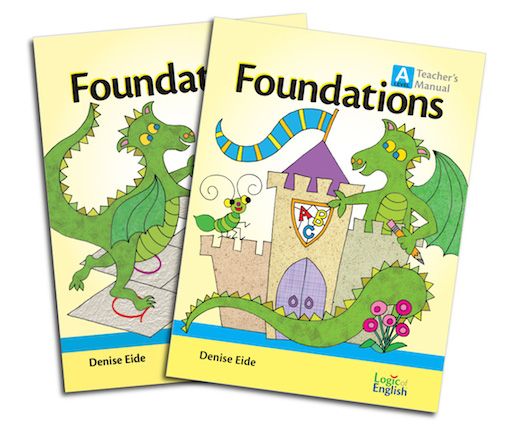Foundations Level A is the first level out of 4 levels in their Foundations series curriculum. It is meant for pre-kindergarten or kindergarten age children. Just as the name implies, this curriculum lays the foundation for reading and writing. It teaches phonemic awareness, handwriting and phonograms. Towards the end of the lessons, spelling is also introduced. These concepts are taught using a multi-sensory, fun approach. This includes not only the student workbook but using shaving cream to write letters in, throwing balls in a basket upon getting an answer correct, using legos, chalk, and other household items to help solidify the lessons.
Foundations Level A include:
- The Teachers Manual- This is a hard bound book that has 40 lessons and 8 review/assessment lessons. Each lesson clearly spells out everything you need to do and even what to say to teach the child the concept they are learning.
- The Student Workbook- This comes in either manuscript or cursive edition and has worksheets for the student to complete for each lesson. The pages are perforated for easy removal. This workbook also has 6 tear-out easy readers in the back.
- Doodling Dragons- This is a hardbound ABC book of sounds that is read throughout the lessons to help reinforce the phonograms being learned.
Other materials that are also used with not only this level but all 4 levels of Foundations are:
-Phonogram and Spelling Rule Quick Reference
-Rhythm of Handwriting Quick Reference Chart
-Rhythm of Handwriting Tactile Cards
-Phonogram Game Cards
-Student White Board
-Basic Phonogram Flash Cards
-Phonogram Game Tiles
-Spelling Analysis Card
At the beginning of each lesson, the teachers manual outlines the objectives of that specific lesson as well as lists what materials are needed for the lesson. From there, it walks you through step by step on what to teach and how. The lessons are scripted which takes the guess work out how to present the lesson to the child.
The first part of the lesson covers phonemic awareness, using a kinesthetic approach. The involves sometimes feeling for air that comes out of the mouth, feeling your throat vibrate, noticing the placement of your tongue when a certain sound is made, etc. Each letter is taught with all of the different sounds it makes. Blending sounds are also worked on during this part. By teaching all the different phonograms rather than just the letters helps the child learn to decode words rather than just learn to sight read.
The next part of the lesson works on handwriting. In the beginning lessons, the student is taught how to make different strokes that they will eventually tie together to form letters. Instructions on teaching both manuscript and cursive are in the teachers manual. Olivia would practice making the different strokes on the white board and eventually write them in the workbook.
Further along in the lessons, phonogram practice is introduced. This is done through a variety of activities using the different game cards that came with the curriculum as well as creative activities such as writing the phonograms in chalk on the driveway and bouncing a ball on the correct sound. Eventually spelling and reading also become part of the lessons.
Throughout each lesson in the teachers manual, you will find different colored boxes on the side of the pages. These are different tips for the teacher, challenge suggestions as well as multi-sensory fun ideas. There are SO many suggestions for each lesson that we didn't always manage to use all the ideas. In fact, this was the reason we did just 2-3 lessons a week as we'd review each lesson using a suggested activity we didn't do the first time around. Or we'd take a game suggestion from a previous lesson to use with the current phonogram we were learning.
The first part of the lesson covers phonemic awareness, using a kinesthetic approach. The involves sometimes feeling for air that comes out of the mouth, feeling your throat vibrate, noticing the placement of your tongue when a certain sound is made, etc. Each letter is taught with all of the different sounds it makes. Blending sounds are also worked on during this part. By teaching all the different phonograms rather than just the letters helps the child learn to decode words rather than just learn to sight read.
The next part of the lesson works on handwriting. In the beginning lessons, the student is taught how to make different strokes that they will eventually tie together to form letters. Instructions on teaching both manuscript and cursive are in the teachers manual. Olivia would practice making the different strokes on the white board and eventually write them in the workbook.
Further along in the lessons, phonogram practice is introduced. This is done through a variety of activities using the different game cards that came with the curriculum as well as creative activities such as writing the phonograms in chalk on the driveway and bouncing a ball on the correct sound. Eventually spelling and reading also become part of the lessons.
Throughout each lesson in the teachers manual, you will find different colored boxes on the side of the pages. These are different tips for the teacher, challenge suggestions as well as multi-sensory fun ideas. There are SO many suggestions for each lesson that we didn't always manage to use all the ideas. In fact, this was the reason we did just 2-3 lessons a week as we'd review each lesson using a suggested activity we didn't do the first time around. Or we'd take a game suggestion from a previous lesson to use with the current phonogram we were learning.
After every 5 lessons, there is a review and assessment lesson. There is a check list of skills with either a 1, 2, or 3. Because this is a mastery based curriculum, there are certain skills the student has to know before moving onto the next set of lessons. This is indicated with the number 1 next to it.
This is a very thorough language arts curriculum that can be adapted to fit many different learning styles. My daughter has enjoyed this curriculum! She likes how they offer a variety of hands on activities and games to keep the lessons fresh & not repetitive and boring. I am anxious to see where she is at with reading by the time we finish!
This is a very thorough language arts curriculum that can be adapted to fit many different learning styles. My daughter has enjoyed this curriculum! She likes how they offer a variety of hands on activities and games to keep the lessons fresh & not repetitive and boring. I am anxious to see where she is at with reading by the time we finish!

















No comments
I enjoy hearing from each & every one of you! Thanks for taking the time to comment. :)